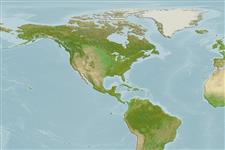Common names from other countries
Classification / Names / Names
Common names | Synonyms | Catalog of Fishes (gen., sp.) | ITIS | CoL | WoRMS
Environment: milieu / climate zone / depth range / distribution range
Ecology
Benthic; depth range 0 - 40 m (Ref. 96667). Subtropical; 23°S - 30°S, 133°W - 109°W (Ref. 4)
Pacific Ocean.
Length at first maturity / Size / Weight / Age
Maturity: Lm ? range ? - ? cm Max length : 25.0 cm TL male/unsexed; (Ref. 101422); common length :24 cm BL (female)
It has lengths of 15 to 25 cm (male) and 15 to 24 cm (female) total body length; 6 to 10 cm (male) and 6 to 9.5 cm (female), carapace length (Ref. 4). Littoral to sublittoral (Ref. 77016). Found in shallow water, from 1 to 5 m deep in crevices of rocky substrates (Ref. 4). Nocturnal. Omnivorous. In general, thorny lobsters have a consistent diet of gastropods, fish remains, decapod, red algae, and brown algae (Ref. 107049).
Life cycle and mating behavior
Maturity | Reproduction | Spawning | Eggs | Fecundity | Larvae
Impregnated and ovigerous females have been taken in December (Ref. 4).
Holthuis, L.B. 1991. (Ref. 4)
IUCN Red List Status (Ref. 130435)
CITES status (Ref. 108899)
Not Evaluated
Not Evaluated
Human uses
Fisheries: commercial
| FishSource |
Tools
More information
Age/SizeGrowthLength-weightLength-lengthMorphologyLarvaeAbundance
Internet sources
Estimates based on models
